Baikal. A thirst for life. A story of one dive.
People who worked on the issue.
Gennady Misan - instructor-trainer IANTD, Advanced Trimix instructor TDI, instructor CMAS3*. A professional diver since 1988. More than 8000 dives, most of them - on Baikal. Personal achievements: record of Russia in cold water diving- 154m (December 2005), 85m night dive (2006, New Year) .
Not all technical dives end up successfully; unforeseen circumstances often make an elaborate dive plan go completely wrong. What will a person do when it's a question of life and death? Give it all up and submit or fight till the end trying to find the way out? On January 9th Gennady Misan had a 155m dive that could have ended tragically, but due to accurate work of the diver and the support team we can learn all the details not from a police record, but in the diver’s words.
About diving on Baikal.
A typical dive site on Baikal is a shallow shelf, 10-200m long, turning into a vertical wall. There are only 6 sheer walls going more than 100-120m into the deep. Usually, to make a guaranteed more than 100m fall you have to stand on the edge of a drop-off and move along the surface until the wall is out of sight, and then, 30-40m more. That is, the fall always takes place in the abyss, with no markers, and from 110m (even 50 f the visibility is bad) - in complete darkness. Coming to the surface starts along the seabed and the slope, then along the wall. I don't like diving along guideline ( life-line) and don't practice that. The fall is just a few minutes and after that - hour and a half long decks in deep blue. That's really something special! Those who dived on Baikal will understand. Free fall and surfacing allows you to enjoy the incredible beauty of nature when you look up and down from 100m and see picturesque canyons, mountain ranges, grottos. This severe beauty captures you.
Water temperature in depths of over 60m is always not more than +4. On the surface it depends on a season. In December-January it's +1+2. The thing is that the temperature is the same in all depths available to Trimix divers at this time.
How it all had been planned...
Why had I planned diving in January? The answer is simple. Such dives need profound self-preparation and well-trained buddys. It's not a "why-don't-I-do-it-today?" thing when you wake up in the morning, decide to go to the dive centre, put the equipment into the van, one hour -  and you're there. Whole summer and autumn work kept me busy. I'd done my previous 154m dive solo. There was only safety equipment on the surface, and in the middle of the dive the stander-by came down to me to see if everything was going well. Other 100-140m dives I had only done with the safety equipment on the surface (except those connected with courses and deep-water support). I'm not sure I was right then. The shoulder of a buddy is a great emotional support and a real help. Now I don't dive deep alone. In September, Andrei and I began preparing for deep dives. Andrei has been doing Trimix diving for quite a while, passed IDC for technical instructor. We needed trainings to prepare for diving in complete darkness, especially in two. We'd been doing this for a few months interrupted by routine work in dive club. In December there were four 55-60m ER dives; 70,90m trimix dives; and on January 3d - 100m. Rejections of equipment - only Andrei’s Legend frozen when going into the water (70m dive). The regulator underwent technical service and next dives went successfully. My equipment never failed. 160m dive was planned for January 9th.
and you're there. Whole summer and autumn work kept me busy. I'd done my previous 154m dive solo. There was only safety equipment on the surface, and in the middle of the dive the stander-by came down to me to see if everything was going well. Other 100-140m dives I had only done with the safety equipment on the surface (except those connected with courses and deep-water support). I'm not sure I was right then. The shoulder of a buddy is a great emotional support and a real help. Now I don't dive deep alone. In September, Andrei and I began preparing for deep dives. Andrei has been doing Trimix diving for quite a while, passed IDC for technical instructor. We needed trainings to prepare for diving in complete darkness, especially in two. We'd been doing this for a few months interrupted by routine work in dive club. In December there were four 55-60m ER dives; 70,90m trimix dives; and on January 3d - 100m. Rejections of equipment - only Andrei’s Legend frozen when going into the water (70m dive). The regulator underwent technical service and next dives went successfully. My equipment never failed. 160m dive was planned for January 9th.
Buddy. Andrei Slepnev - ATMX TDI. Great experience in diving on Baikal. Dives "techno".
Supports. Andrei Slepnev - ATMX TDI, Tatyana Oparina (ATMX TDI, Advanced EAN Instructor IANTD), Sergey Polovnikov (OWD diver).
Gases. TM 8/67 (double tank 12*2), TM 14/50 (deco 12l, alum.), TM 32/20, EAN 60 (I use the same gas for inflate of my dry suit), O2 Aboard is spare oxygen and EAN50 in case we lose deco gas.
Equipment. Suit – HD Pro Dry Trilam Bare + dry gloves, undergarment- warm woolen underwear + Weezle Extreme+, computers – VR 3,the torch – Metal Sub 50 + a spare one, Lola. Oxygen regulators – Apex ATX 50, main regulator – Apex TX 100 (connected to the right inflator), spare one – Apex ATX 50 (on the left inflator), wing Dive Rite Dual Rec with DIR mount, steel back. I always use the wing as a mount only and as a spare system of buoyancy. Inflate only a dry suit.
Dive site. “Baranchiki”. One of vertical walls going down more than 120m. Approximate visibility is 50m (had dived there 10 days before). Water is nearly frozen – sludge ice is all along the Circum-Baikal Railway.
The plan. The ship comes to the edge of the drop-off. There had been many dives here before. The wall is about 30m away from the shore. Andrei and I go into the water, move away from the wall along the surface. Sheer wall is in sight. Fall together to 100m. Here Andrei stays to wait, his exposition-10 minutes. His other task is spare decompression gas. I keep on falling up to 160. One minute on the bottom, and I start surfacing immediately. At 100m I meet Andrei again – go on surfacing together slightly moving to the right. At 16m – where it is transition to EAN60 – meet the first support ; if needed, give him the used travel gas. He supports us until 6m stop. At 6m, we meet with the second support. He is to control how we feel.
Total time of diving is 98 min.
A supports on the surface must control the entire process of diving. In case a buoy appears or any unplanned situation occurs, he must send a boat and help get aboard.
There were two other groups of recreation divers on board who dived on their own.
…and what it turned out to be like.
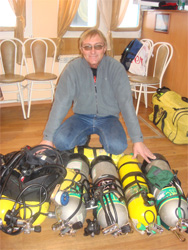 January 9th. 10 Am. Our live-aboard is heading for the dive site. Cloudy. It’s warm (-8) and Baikal is calm. We come across not very big isolated floes. Water temperature is at the point of freezing. On our way we are packing the equipment in a warm lounge, check everything one more time and talk over the order of actions. We reach “Baranchiki” at around 12. Visibility is zero. We can’t see the edge of the drop-off. Sounding shows 70m. We moored fine. I came into the water; Andrei had problems with his equipment, therefore, delayed. The edge of the drop-off was all a blur, which means visibility was no more than 20m. I decided not to wait for Andrei and having co-ordinated with the stander-by, started the descent.
January 9th. 10 Am. Our live-aboard is heading for the dive site. Cloudy. It’s warm (-8) and Baikal is calm. We come across not very big isolated floes. Water temperature is at the point of freezing. On our way we are packing the equipment in a warm lounge, check everything one more time and talk over the order of actions. We reach “Baranchiki” at around 12. Visibility is zero. We can’t see the edge of the drop-off. Sounding shows 70m. We moored fine. I came into the water; Andrei had problems with his equipment, therefore, delayed. The edge of the drop-off was all a blur, which means visibility was no more than 20m. I decided not to wait for Andrei and having co-ordinated with the stander-by, started the descent.
1st minute. Everything is according to the plan. At 20m I switch over to the bottom mix. Can’t see the wall.
3rd minute. At about 80m there is no daylight. Only torch lights. I’m outstripping Andrei a lot and hope he is falling not far from me. I reach 100m and fall further. No wall is seen. I start revolving to see the wall in the torchlight.
4th minute. 130m. There is the wall. I’m 5m away. I light down – the wall seems to disappear in the abyss. Start braking.
5th minute. 150m. I’m going down slowly. The wall is still 5m away. It’s really close, the bottom isn’t visible. Somewhere from underneath the air starts going out slightly. I stop at once and begin surfacing. The depth is 155m. I can’t understand where it is going from – some stage? An air current becomes very powerful and I realize that through a spare regulator, at a great speed, my bottom trimix is going away! In a couple of seconds I am pulled up. Subconsciously, I realize that it’s probably the left inflator; automatically turn off the tap and do my best to veer. At the same time, out of four stages I find the one with the gas I need.
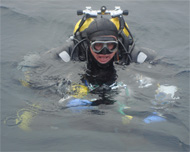 7th minute. 125m deep. The tap is turned off, though bottom gas is gone. Finally, the right regulator is found. I hectically switch over – what if I mixed up the gases? Regulator on stage is at free-flow. I don’t pay attention, it’s of minor importance. Fail to stop. Can’t see the wall, start surfacing in the abyss. While switching over to travel, I lost the valve of veering on dry suit. I’m trying to veer the suit and the wing simultaneously. The valve is turned on, but it can’t cope with the air volume. Coming up is out of control.
7th minute. 125m deep. The tap is turned off, though bottom gas is gone. Finally, the right regulator is found. I hectically switch over – what if I mixed up the gases? Regulator on stage is at free-flow. I don’t pay attention, it’s of minor importance. Fail to stop. Can’t see the wall, start surfacing in the abyss. While switching over to travel, I lost the valve of veering on dry suit. I’m trying to veer the suit and the wing simultaneously. The valve is turned on, but it can’t cope with the air volume. Coming up is out of control.
8th -9th minutes. I’m going straight up trying to stop. Around me is complete darkness. At some point I faint. See nothing, everything is hazy.
10th minute. I wonder how I managed to come round and go on fighting for life. 35m. It turned out that apparently automatically I switched over to TM32/20 and it also was at a freezing point. Coming up slows down. At 28m I managed to finally stop. Exhausted, out of breath. Fits of suffocation. There isn’t enough air. Still feel dizzy. I assume I’ve got respiratory form of DCS. There’s a wall of small bubbles in front of me coming from the deep. I assess the situation: bottom gas is off; travel 32/20 is nearly off. There is TM 14/50, half of EAN60 and pure oxygen left. I felt awful. I didn’t wish to go deep down and cover the missed stops. After the assessment of the speed of coming up and its consequences, I decided to switch over to pure oxygen and go for coming up. I tried to figure out where the drop-off was. Started moving in a supposed direction. I should have come up to where I had switched over to EAN60, then move on and switch over to pure oxygen. But I thought that in my situation the sooner I started breathing oxygen, the better. It has no nitrogen, so it was supposed to lessen the degree of DCS which was meant to kill me as soon as I was up there.
After a couple of minutes of breathing oxygen, moving towards the drop-off and coming up there were no changes in the way I felt – it didn’t get worse. I kept on coming up. After four minutes I appeared on the surface and saw the drop-off. Gave a signal for help and tried to go down again-at least, 3-4m; I thought I should have decompressed at that depth. After giving it a try I realized that physically it’s out of the question.
17th minute. On the surface I looked around searching for the boat. It was about 70m away from me. I started waving and calling for help. Fits of suffocation came back, I didn’t feel my legs. Relaxed waiting for help. I was breathing oxygen all the time.
Standers-by. Hose had burst on a boat, it was impossible to use it. It was decided to send for the ship.”Valeria” was moored. 5 minutes before recreational divers had gone in the water; not to get over their heads when leaving it was decided to send one of the standers-by to them. It took no more than 2 minutes as he had already been ready to come into the water. Divers were found by the bubbles and were ushered onto the shore. The ship headed for me. 20 minutes after surfacing arrived help in the person of my buddy who, when realized that everything had gone wrong, had decompression as soon as he could and came up to the surface. And help provided by “Valeria” crew. I wasn’t able to take off the equipment and get aboard myself; besides, it was better not to move at all. My baddy helped with the equipment, the “Valeria” crew in icy water up to their knees were trying to help Andrei. Finally, I was lifted, taken to the cabin, released of the equipment and given pure oxygen. I’m very grateful to the crew and my buddy for their professionalism and cooperation.
Post decompression.
My symptoms were numb legs and a feeling that they’d been whipped by nettle. I realized that I was really saved and safe. People usually die of vast DCS in such situation. I survived. Continuous breathing pure oxygen aboard. An immediate call to the pressure chamber of МЧС (Nicola settlement) and heading for Listvyanka. On my way I drank about 2 litres of water. Suffocation was gone. I could feel my legs. Sensitiveness to cold appeared. Even a slight temperature fluctuation – opening and closing a cabin door – felt like a burn. About an hour after getting aboard I felt extremely tired. Though I didn’t feel like sleeping. I didn’t observe any other symptoms like aching joints, rash, paralysis, shiver, fever, etc. When we arrived in Listvyanka I felt fine, though very tired. We drove to МЧС. It had been 3 hours since coming up. As I felt alright, I refused to undergo any treatment. At the moment, the symptoms were exhaustion and the creeps in my legs. It was agreed upon a preventive 30m immersion into the pressure chamber with one hour exposition and the following two hour decompression.
By pressure of 4at the creeps were gone, but by 18m came again, at a lesser degree. Regime remained unchanged. After the pressure chamber I went home, kept on breathing pure oxygen. Around 11pm the back surface of thighs and calves got numb. Sensitiveness to cold was stronger. Slight local massage gave temporary improvement. As I stayed physically active, no measures were taken.
On January 10th I was sleeping all day, exhaustion got away by evening. Didn’t breathe oxygen that day. Numbness remained. January 11th was a usual work day. The muscles were numb, but it didn’t affect physical activity. These kinds of symptoms – suffocation, numbness, weakness – are referred to the signs of a serious form of DCS affecting central nervous system. The lung form of DCS (that started when I was still underwater) takes place only in 2 percent of cases. Also, it is a rare thing when all mentioned symptoms aren’t accompanied by any others.
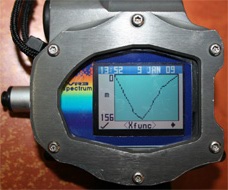 On January 12th, at 11am, I had a 40min long session in the oxygen pressure chamber, by pressure of 1,8at. After that numbness became weaker. The same day, a diving expert of MES (Ministry of Emergency Situations, Valery Chernikh phoned Boris Nikolayevich Pavlov. Based on the symptoms, I was considered to have a serious form of DCS. The 2ndregime of medical recompression was recommended. Personally, I thought that I didn’t have DCS but the remaining signs connected with the trauma of soft tissue.
On January 12th, at 11am, I had a 40min long session in the oxygen pressure chamber, by pressure of 1,8at. After that numbness became weaker. The same day, a diving expert of MES (Ministry of Emergency Situations, Valery Chernikh phoned Boris Nikolayevich Pavlov. Based on the symptoms, I was considered to have a serious form of DCS. The 2ndregime of medical recompression was recommended. Personally, I thought that I didn’t have DCS but the remaining signs connected with the trauma of soft tissue.
On January 13th, at 11am, there was one more session of oxygen therapy (2 hours by 2at). At 8pm I stopped arguing with my wife and МЧС experts and went to the МЧС pressure centre. At 11pm they started medical recompression in the pressure chamber. At 70m all symptoms disappeared, but after coming up to 38m came back. After consulting the МЧС experts by phone we moved on to the 3rdregime of recompression. Total time in the pressure chamber – 60 hours and 45 minutes.
After all the measures taken we can say that DCS is completely eliminated. The symptoms connected with the trauma of soft tissues remain. Further treatment – by vitamins.
That’s how we dived.
Analyzing what happened.
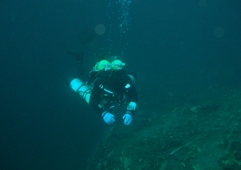 This diving should have been cancelled at the beginning when the buddy had задержки. Murphy says: “If a few misfortunes are to happen, they happen in the most unfavorable order”. And, “The greater is the preparation for an exceptional dive, the fewer are the chances to refuse it even if it turns out to be a failure”.
This diving should have been cancelled at the beginning when the buddy had задержки. Murphy says: “If a few misfortunes are to happen, they happen in the most unfavorable order”. And, “The greater is the preparation for an exceptional dive, the fewer are the chances to refuse it even if it turns out to be a failure”.
This time I didn’t do what I always mention at all technical courses: stop diving if something goes wrong. I didn’t wait for my buddy; and though there was nothing he could really do to help me in that situation, I started diving. However, this dive happened the way it happened. It was unique in its way. Unique meaning the fact that the diver survived and is quite well. So, why I am safe and sound:
1. The diving was short and there wasn’t great saturation.
2. Breathing pure oxygen from 28m and constant breathing on the surface until the buddy and “Valeria” arrived.
3. Refusing to go deep down and cover the missed stops, although, it was quite possible – gases were enough, and they might as well have been brought by standers-by.
4. Professionalism of the buddy and “Valeria” crew in taking off the equipment and getting aboard and, as a result, an absolute lack of physical work.
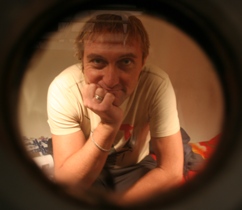 5. Constant breathing of pure oxygen being on board.
5. Constant breathing of pure oxygen being on board.
6. What is important is that despite almost a throw-out, the diver didn’t lose the sense of self-control and didn’t fuss about trying desperately to save himself.
The issues to mention about this dive may be as follows:
1. You shouldn’t make experimental dives when the water is about to freeze. My second regulator just got frozen in very cold water under great pressure, without even starting working.
2. The buddy, a good security team, understanding ship crew, a good ship – it’s more than 50% of success. I made a mistake having started the dive, but my buddy, standers-by and the crews helped me finish it more or less safely.
There is always a chance to survive. Only those who think and prepare have it. You mustn’t give up, you must fight. But you must fight right. Very often concentrated, persistent, unthinking self-rescuing actions lead to death.
Further plans.
Baikal is covered with ice at the moment. Deep dives are closed until May. Before, we made trimix dives in port Baikal where it is deep and the water is open even in severe frost. But aforementioned story shows that deep dives at temperature of freezing are too dangerous. Deep diving has been planned in April, in Palau. In May – deep sunken ships in the Baltic. In the end of May we start Baikal deep water training and will practice diving with buddys. 60-80-100-110-120-130. After that... There is an idea to make a 160m dive in two or in three, and exactly on Circum – Baikal Railway where the bottom can offer you so many interesting things.
Gennady Misan, Magazine "InVertum' №4 2009 and X-RAY Magazine №30